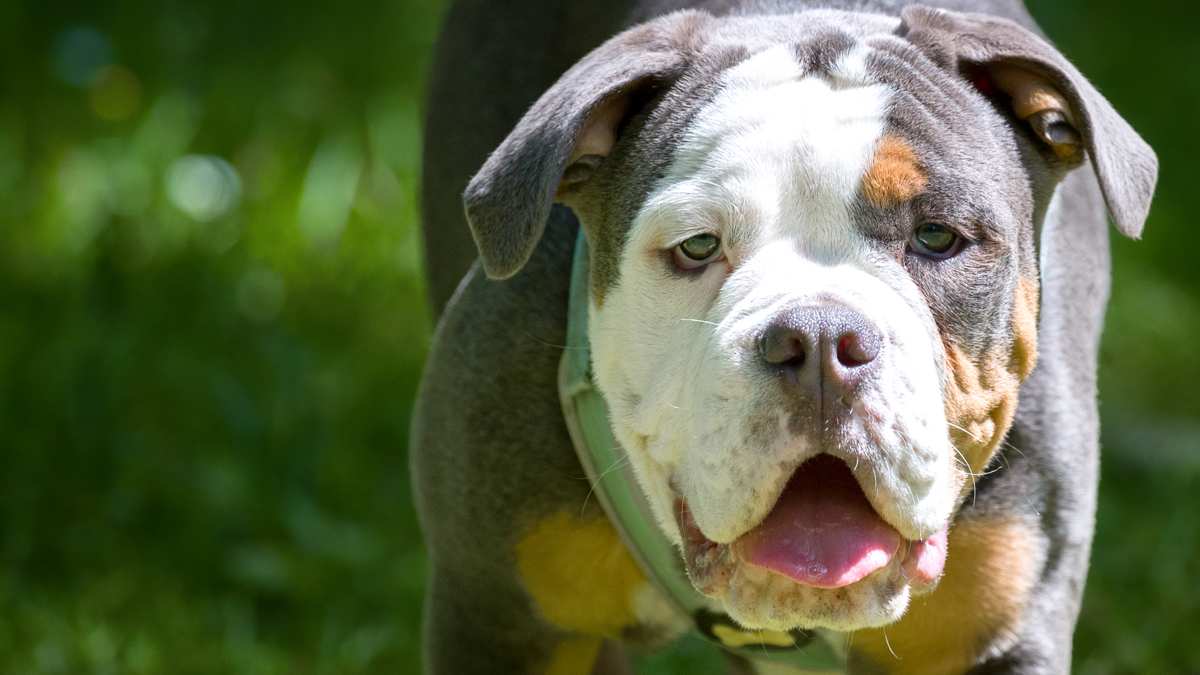Dorset Olde Tyme Bulldogge Breed Details
Below are details and specs for the Dorset Olde Tyme Bulldogge breed.

The Dorset Olde Tyme Bulldogge, also known as the Old Time Bulldog, is a fairly new (and somewhat rare) breed of bulldog that originated in England in the 1980s. Highly muscular, extremely confident, and quite docile unless provoked, a Dorset bulldog is a playful, loyal, and willing-to-please animal, and makes an excellent watchdog. This streamlined, athletic, breed, created to be an "ideal bulldog," is a great family companion.
Below are details and specs for the Dorset Olde Tyme Bulldogge breed.
On the large side of medium-sized; both male and female Dorset bulldogs weigh 60-90 pounds, and stand 19-24 inches at the shoulders.
Confident and proud, yet calm and affectionate, this breed is an excellent family dog. It is protective of its owners, but at times stubborn; it will socialize well with most other pets, but may be a bit dominant with other dogs.
These dogs are hardy and adaptable, and needs little care. A daily walk and some outdoor playtime should suffice. Those without time to train them as a puppy might find them challenging and a bit stubborn.
Though it was developed quite recently, the Dorset bulldog has quite an interesting origin. In the late 1980s in Great Britain, a well-known bulldog breeder named Steve Barnett sought to create what he called the "ideal bulldog" – one that was healthier than other bulldog breeds of the time, and more closely resembled the bulldogs in England during the 1500s, when British royalty used them to bait bulls and bears. According to a report published in the early 2000s by the Dorset Olde Tyme Bulldogge Club of Scotland, Barnett said his objective was to "produce a national bulldog; a dog you can stand alongside proudly, confident in the knowledge that he is an athlete; capable of non-stop energy, looking like a true gladiator; a bulldog both in appearance and temperament." Barnett researched the appearance of various bulldog breeds through the centuries; then, for about a decade, he crossbred various bulldogs (many of which were true English bulldogs) until he developed a streamlined, short-muzzled, muscular variant that he'd sought. He called this new breed the Dorset Olde Tyme Bulldogge to honor its heritage.
Today, though these dogs are somewhat rare outside the U.K., Dorset bulldog breeders can be found around the world.
The Dorset bulldog's coat is short-haired, smooth, and flat. This medium-sized breed has a body that is a bit greater in length than in height; the roundish head has a short, "pug-nosed" muzzle, hanging jowls, and an abundance of wrinkles or folds. Eyes are round and brown, and ears are high-set, triangular, and either "perky" or hanging slightly. The Dorset's chest is deep and broad, and its shoulders are prominent and very muscular. The forelegs are straight and set wide apart; the back slopes slightly from front to rear, and the hind legs are angled back slightly, contributing to the Dorset's streamlined look. The medium-length, hanging tail is either straight or curved slightly, and is often docked to a quarter of its length.
The images below represent the coat colors and patterns associated with Dorset Olde Tyme Bulldogges.
True to breed creator Steve Barnett's wishes, The Dorset virtually oozes confidence. This breed is proud, extremely strong (yet surprisingly agile for its build), and completely fearless. At the same time, a Dorset is gentle, even-tempered, and extremely loyal to its masters. These dogs make excellent family companions because they are affectionate and friendly towards people of any age, and are very protective of their human "pack." Some Dorsets are known to be a bit stubborn and "bull-headed," so to speak, so experts suggest positive reinforcement and consistent but gentle training, done so when the dog is a puppy if possible, to teach a Dorset proper obedience.
The Dorset bulldog is fairly low-maintenance. Not much training will be needed, nor much grooming; only a fair amount of exercise will be necessary.
This breed sheds moderately, but will only need brushing once or twice a week; baths are necessary only occasionally. The skin folds in a Dorset's face tend to collect debris, so they should be checked often, and cleaned with a damp cloth if necessary.
Dorsets are very adaptable to any physical lifestyle, and can handle a lot or very little exercise, depending on their living situation. These dogs can be very playful, and will love any outdoor games; a daily walk is also great.
This breed is extremely flexible, and can live basically anywhere – house or apartment, indoors or out.
Life expectancy is 12-14 years. This breed is extremely healthy; no issues are known.